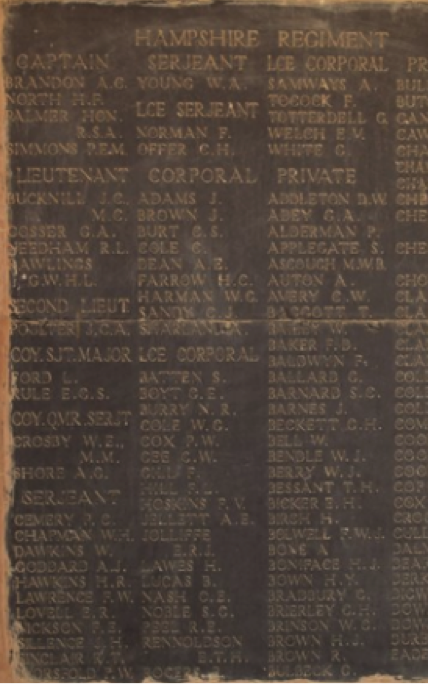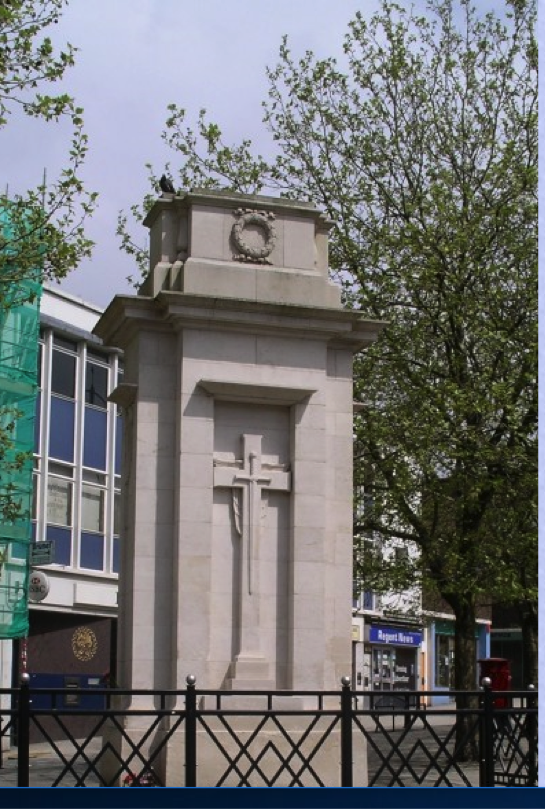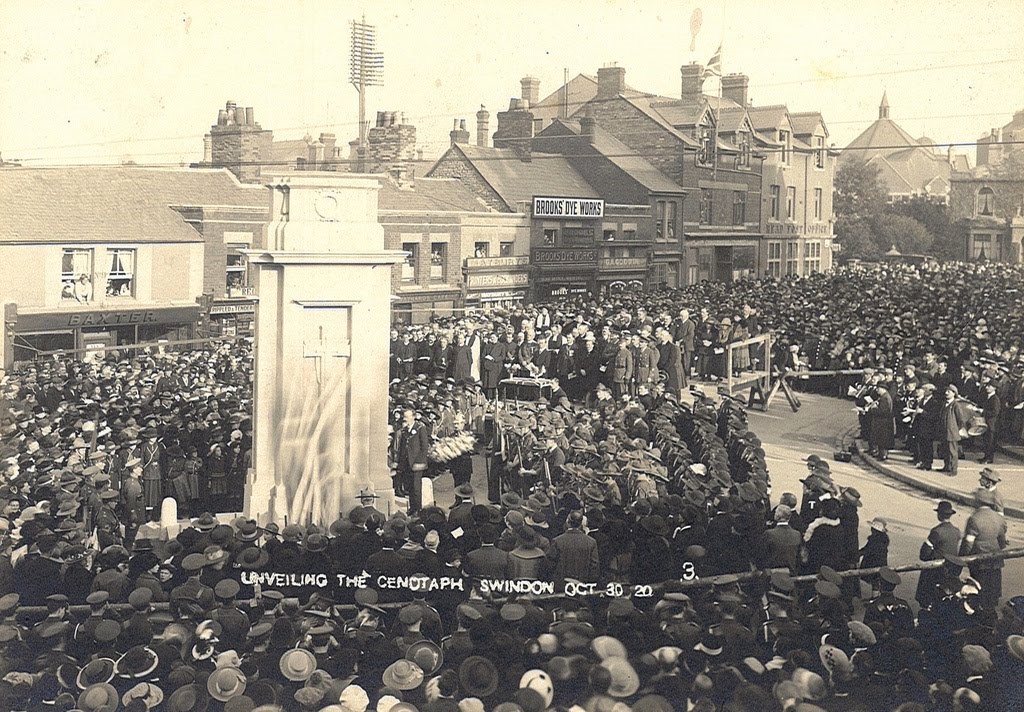
Christopher Stigant Burt
Corporal Christopher Stigant Burt, regimental Number 2000497, of the 1/4th Hampshire (T.F.) Battalion, was killed in action at the Hanna Defile (Umm-el-Hannah) in Mesopotamia, on the 21st January 1916.
Family Life
Christopher was born on the 10th March 1892 in Southwark, London, to Christopher George Hirons Burt and Clara Eliza Burt (née Stigant). Clara Eliza Stigant had a difficult childhood. Records show that she spent time in a workhouse with her sisters Lilly and Marion. Their brother Frederick has not been found in the Workhouse Records. The Discharge Register for 1883 records that the sisters were admitted after having been deserted by their parents. They were transferred the following day to St George’s Workhouse, Mint Street, Southwark. They were later transferred to Hanwell Schools, which, in 1896, admitted Charlie Chaplin and his brother. Their mother Clara Louisa was convicted of receiving stolen goods with a previous conviction for felony in March 1883. She was sentenced to six months imprisonment with hard labour. After her release from prison records show that she was admitted to the Workhouse in September 1883. She is admitted again in 1901 and in May 1904, aged 63, and described as a cook. She was twice acquitted in 1877 and 1890 for attempting to cheat. In 1859 her son Frederick also found himself in court for larceny by a servant, a charge on which he was acquitted.
Christopher’s parents had 10 children: Clara (born 1890), Christopher (born 1892), William (born 1893), Lilly (born 1895), Samuel (born 1898), Miriam (born 1901), Richard (born and died 1902), Clyde (born 1904), Horace (born 1909) and Ralph (born 1910). In the census of 1901 the family was living at 55, Ripley Road (or Place, the writing is difficult to decipher). Christopher’s father was recorded as George in this census. His occupation appears to be copper gauger but as this has been written over it is impossible to say for sure. There was a cable making factory close to where the family was living so perhaps this was where he was employed. Christopher (9) was the oldest child who was living at home with his parents. It has not yet been discovered where his elder sister Clara was at the time of the 1901 census. There were four younger siblings also living there, William (7), Lilly (5), Samuel (3) and Miriam (9mths). Christopher began his schooling along with his sister Clara and brother William at the Harrow Road School.
After the family moved to Swindon, Christopher attended Sanford Street Council School, before moving up to the Secondary School in Swindon.
Unusually Christopher was not baptised as a baby, but when he was 16 in 1908, he was baptised in Swindon along with his 14 year old brother William. They were living at 244, Ferndale Road, and their father was recorded as a traveller. This was what we would understand as a commercial traveller.
By 1911 the family had moved to 198, Ferndale Road, Swindon, Wiltshire. According to the census return this was a house with six rooms, not including bathroom, landing, lobby or scullery. Christopher’s father, now listed as Christopher rather than George as in 1901, was a draper’s assistant. Christopher, at 19, was a student teacher with the Borough Council. He was beginning to learn his profession at Ferndale Road Secondary School, Swindon, staying on as an assistant teacher for a while before going to Winchester Training College. Samuel and Miriam were school students and there were new additions to the family, Clyde Thomas (7), Horace James (2) and Ralph George (6 mths). The eldest child, Clara, was working as an under-parlourmaid in the household of Henry and Mabel Birchenough, a Company Director, residing at 79 Ecclestone Square, London. Lilly and William are not in the family home on this census, and so far no census record for them in 1911 has been found.
Preparing for a Career in Teaching
By the time Christopher was thinking of a job in the teaching profession the old system of a five year apprenticeship as a pupil teacher had changed. The school leaving age had been raised to 15 and there was an alternative route into teaching. Students could take an examination to qualify for a bursary. This would enable them to remain in school studying for another year. Following their time as a bursar they could then become a student teacher prior to applying for entry to a training school. This is the route that Christopher took. In 1908 the Swindon Advertiser and North Wilts Chronicle reported that the Swindon Education Committee had decided that Christopher was not eligible for a bursary but as he wanted to become a teacher they awarded him a scholarship, of free education and £12, to enable him to continue his studies. The following year the newspaper reported that he would be awarded the bursary with a maintenance grant of £30 on the condition that he would serve for one year as a student teacher after his bursary expired. In 1910 the paper had an article on prize winners which included Christopher passing an examination in drawing the outline of a plant. In 1910 Christopher took the Preliminary Examination for Certificate, which allowed him to apply for a place at a training college. While working at the Swindon Secondary School he had taken a course in physical training. He also took the Archbishops’ Examination for admission for which he was awarded a second class pass. Other exams that Christopher took, before entering college, included Organic and Inorganic Chemistry, which unfortunately he failed, were: Physics (Sound, Light and Heat), and Drawing exams in Memory, Freehand, Outline, and Light and Shade. (Find out more about the Teacher & Training College here)
Winchester Training College
Winchester Training College photograph courtesy of Alwyn Ladell
In 1911 Christopher began his two years of training at Winchester Diocesan Training College. The College magazine, The Wintonian 1910-1914, had a report in the Territorials section about the shooting competition. Private Eason was awarded first prize with a score of 74 points and Christopher was second with a score of 72. Christopher was the Treasurer of the Sports Club in his time at College.
In his first college exams at Christmas 1911, Christopher was placed 8th on the order of merit with an average mark of 68.2%, but by Christmas of the following year he had slipped down to 27th place with an average mark of 59.1%. At the end of his time at College, Christopher was graded as achieving an A in Physical Training, a B for Music, Reading, Drawing and Science, and a C for Teaching. At the end of his first year Christopher achieved a Class 1 pass, and a Class 2 at the end of his final year.
In the Wintonian magazine Christopher was reported as attending the first Winton Reunion Meeting in London for the group of students who had attended College between the years of 1911-13.
After completing his course at College Christopher got his first teaching appointment at a Church of England school in Whitton, Twickenham, Middlesex.
Mesopotamia
Over 80 from our village are with the Forces of the King, Bravo Whitton!
The same local newspaper in November of the following year reported:
Lately no news has been received in the village from Mr. C.S. Burt, who before joining the 4th Hants Regiment in August 1914 was assistant master to Mr .H.E. Brown at the Church of England Schools. After a period of training in this country he went to Poona and from there to Rawal Pindi, and it may be credibly supposed that he is now with the Persian Gulf Expeditionary Force.
Panel of the Basra War Memorial showing Corporal C S Burt
Photograph courtesy Royal Hampshire Regiment
The Middlesex Chronicle published on Saturday 13th May 1916, carried the following article which showed that several months after his death, they were still awaiting news.
News of Whitton Warriors
The fate of another popular figure in the village who donned khaki immediately after the first call to arms, and of whom nothing has for some time been heard, is giving rise to much anxiety. He is Cpl Christopher S Burt, of the 4th (Territorial) Batt of the Hants Regt. Twelve months before the outbreak of the war he came to the Whitton Church of England Schools straight from Winchester Training College, as an assistant master, and in addition to becoming a favourite with the children, of whom he had the educational care, he earned the esteem and regard of all connected with the local company of the Church Lad™s Brigade (which he commanded up to the time of his joining the forces) and the Whitton Athletic Club, and the zeal he exercised in promoting the welfare of the schoolboys in the matter of sport added to his popularity. After serving with his regiment for a time on Salisbury Plain he proceeded to India, where he remained until the spring of last year, eventually joining the force sent to the relief of General Townshend, under command of General Nixon. On January 16th this year he wrote a card to Mr H.E. Brown (the headmaster of the schools), stating that he was quite well, and adding letter follows at first opportunity. The card arrived safely, but the promised letter has not been received, neither has any other communication, other than the official announcement that Cpl Burt is missing, which it is sincerely hoped will mean the warrior is safe as a prisoner.
I am very sorry to give you ill news of the fate of our two Companies at Sheik Saad,1 near Kut-el-Amara, on January 21st. The Hampshires seem to have suffered almost the worstThe Colonel2 and Adjutant were killed. All Officers and NCOs being down, a remnant of our fellows reached the trenches. At this point Tarrant and Warne were killedPurkis and HW Rose are missing, probably losing their way in the darknessThat is all the news, which I™m sure you will think is quite ill enough.™
There is no mention of Christopher at all which suggests that at this stage his whereabouts and fate were unknown. He was not recorded as being a prisoner of the Turks, nor did he receive any medical attention at a first aid post or dressing station or he would have been recorded as Died of Wounds™. His official cause of death was recorded as Killed in Action.
Researcher and Author: Dee Sayers
Footnotes
[1] Recorded on the School Admissions Register for Harrow Road School in 1897. Harrow Road School was thought to have been a Special School but the admission registers show no evidence of this and as Christopher went on to become a teacher it is unlikely that he would have been admitted to a Special School.
[2] Although Captain Goddard identifies it as the Battle of Sheik Saad it is now accepted as the Battle of Hanna that took place on the 21st January when Christopher and his three College friends died.
[3] The Colonel referred to in Captain Goddard’s letter was Lieutenant Colonel F. Bowker. His wife Esme later set up a ‘Comforts Fund’ for the Hampshire Regiment men who were taken prisoner by the Turks at the end of the siege at Kut-al-Amara.
Sources
Ancestry (2018) Home page. [online] Available at: www.ancestry.co.uk [Accessed 2018]
Ball, D & M. Photograph
British Newspaper Archive (2018). Middlesex Chronicle – Saturday 13 May 1916. [online] Available at: https://www.britishnewspaperarchive.co.uk/viewer/bl/0000227/19160513/044/0003 [Accessed 2018]
General Register office. (2019). Registration Services – Certificate Ordering Service – Login. [online] Available at: https://www.gro.gov.uk/gro/content/certificates/indexes_search.asp [Accessed 7 Jun. 2019].
Kut 1916 The Forgotten British Disaster in Iraq by Patrick Crowley
The Royal Hampshire Regimental Museum archives, Serles House, Southgate St, Winchester SO23 9EG
Vickers, J. The University of Winchester Chapel Memorial Rail image
War Memorials & Roll of Honours Swindon, Wiltshire. (2018). Home page. Available at: www.oodwooc.co.uk/ph_sw_warmemorials.htm [Accessed 2018]
| University of Winchester Archive “ Hampshire Record Office | ||
| Reference code | Record | |
| 47M91W/ | P2/4 | The Wintonian 1899-1900 |
| 47M91W/ | P2/5 | The Wintonian 1901-1902 |
| 47M91W/ | P2/6 | The Wintonian 1903-1904 |
| 47M91W/ | P2/7 | The Wintonian 1904-1906 |
| 47M91W/ | P2/8 | The Wintonian 1905-1907 |
| 47M91W/ | P2/10 | The Wintonian 1908-1910 |
| 47M91W/ | P2/11 | The Wintonian 1910-1914 |
| 47M91W/ | P2/12 | The Wintonian 1920-1925 |
| 47M91W/ | D1/2 | The Student Register |
| 47M91W/ | S5//5/10 | Photograph of 5 alumni in Mesopotamia |
| 47M91W/ | Q3/6 | A Khaki Diary |
| 47M91W/ | B1/2 | Reports of Training College 1913-1914 |
| 47M91W/ | Q1/5 | Report and Balance Sheets 1904- 1949 |
| 47M91W/ | R2/5 | History of the Volunteers Company 1910 |
| 47M91W/ | L1/2 | College Rules 1920 |
| Hampshire Record Office archive | ||
| 71M88W/6 | List of Prisoners at Kut | |
| 55M81W/PJ1 | Managers™ Minute Book 1876-1903 | |
| All material referenced as 47M91W/ is the copyright of The University of Winchester. Permission to reproduce photographs and other material for this narrative has been agreed by the University and Hampshire Record Office. | ||






